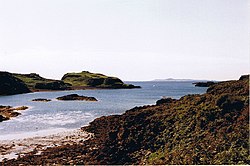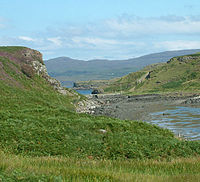Gometra
| Gometra | |

| |
|---|---|
| Location | |
| Location: | 56°29’24"N, 6°17’24"W |
| Grid reference: | NM361414 |
| Area: | 1,050.2 acres (425.0 ha) |
| Highest point: | 509 feet (155 m) |
| Data | |
| Population: | 5 |
Gometra is an island in the Inner Hebrides belonging to Argyllshire and lying west of Mull. It lies immediately west of Ulva, to which it is linked by a bridge, and at low tide also by a beach. It is approximately 1,050.2 acres (425.0 ha) in size. The name is also applied to the island summit.
Name
According to Gillies (1906) "Gometra" is from the Norse gottr + madr + ey and means "The good-man's island" or "God-man's island".[1] Mac an Tàilleir (2003) offers "Godmund's island".[2] The Norse Goðrmaðray may also mean "warrior priest's island". The Gaelic Gu mòr traigh meaning "only at low tide" has been proposed as the meaning of the name, but may be an example of folk etymology. Mediæval charters render the name "Gomedrach".
Geography

The island is agricultural, formerly growing grain for the monastery on Iona.[3] Once home to a population of over a hundred, it is now down to a tight-knit community of a handful of people, up to a thousand black face sheep, highland cattle, pigs, horses, a flock of feral goats, and red deer. Historical sites on the island include an old burial ground, the remains of two duns and old settlements.[3] It has no school, doctor, or ferry. It has a weekly postal service.
The islands is part of the Loch Na Keal National Scenic Area.
History
While neighbouring Ulva belonged to the MacQuarries from the 10th century, Gometra was a possession of the abbey of Iona until its dissolution when the lands passed to the Earl of Argyll. Dean Monro makes no mention of Gometra or Ulva in his 1549 work A Description Of The Western Isles of Scotland but both are referred to briefly by John Monipennie c. 1612, stating of the latter that "about 300 paces from this island, lyeth Gomatra, two miles long and one mile broad".[4]
In 1845 Gometra was sold by the MacDonalds of Staffa to Francis William Clark of Ulva, a lawyer from Stirling, of Morayshire origin[5] who began a brutal clearance of a substantial proportion of the inhabitants of both Gometra and Ulva within a few years.[6]
In 1932, the island was sold to the mountaineer Hugh Ruttledge (1884–1961), who had taken early retirement from the Indian Civil Service and planned a life as a farmer. While living on the island, Ruttledge led two British expeditions to Mount Everest, in 1933 and 1936, and took up sailing. In 1950, he moved to Dartmoor.[3][7]
Gometra House had fallen into disrepair and parts were near collapse by the 1980s, but was reoccupied and restored as a family home in the 1990s.[3] Principal exports include blackface breeding stock, lamb, mutton, wool, venison, oysters, vegetables, art and jewellery. There are currently four households on the island, and the islanders are dedicated to a low-impact lifestyle, living off-grid, doing without electricity in their homes, washing machines or cars on the island.
In 2012 concerns were expressed by islanders about the siting of a large fish farm by the Scottish Salmon Company in Loch Tuath to the north of the island.[8]
Transport
Weather and tides permitting, it takes about 1 hour and 15 minutes to travel by track from the houses on the west of Gometra to the ferry landing stage on Ulva for the crossing to Mull, using a 4x4 vehicle. The same trip can be done in 50 minutes on a quad bike. By boat from Acarseid Mhòr the journey only takes 20 minutes.[8]

Outside links
References
- ↑ Gillies (1906) p. 129.
- ↑ Mac an Tàilleir (2003) pp. 58-59
- ↑ 3.0 3.1 3.2 3.3 Haswell-Smith (2004) p. 105
- ↑ Monipennie p. 186
- ↑ Clan MacQuarrie, A history, R.W. Munro & Alan MacQuarrie, 1986 Ch.6 p.86
- ↑ Haswell-Smith (2004) p. 102-03
- ↑ Salkeld, Audrey, Ruttledge, Hugh (1884–1961), mountaineer in Oxford Dictionary of National Biography, Oxford University Press, 2004, online at Ruttledge, Hugh (1884–1961) (subscription required) accessed 1 March 2008
- ↑ 8.0 8.1 Ross, David (27 August 2012) "Residents of tiny island to fight plan for salmon farm". Glasgow. The Herald.
- Gillies, Hugh Cameron (1906) The Place Names of Argyll. London. David Nutt.
- Haswell-Smith, Hamish (2004). The Scottish Islands. Edinburgh: Canongate. ISBN 1841954543.
- Monipennie, John (1818) An Abridgement, or Summarie of the Chronicles of Scotland with a Briefe description of Scotland, to which is added The description of the Western Isles of Scotland &c. Edinburgh. David Webster. First published c. 1612